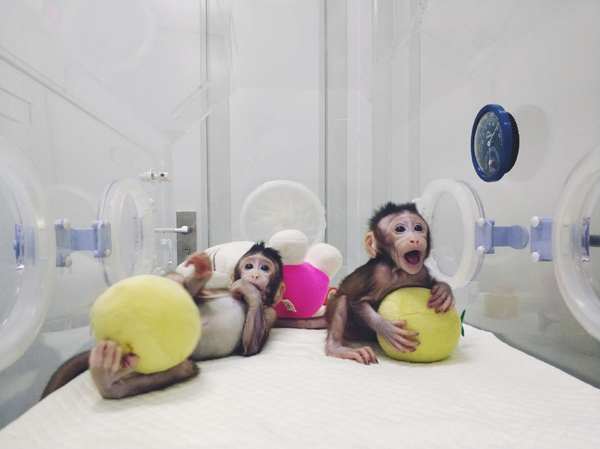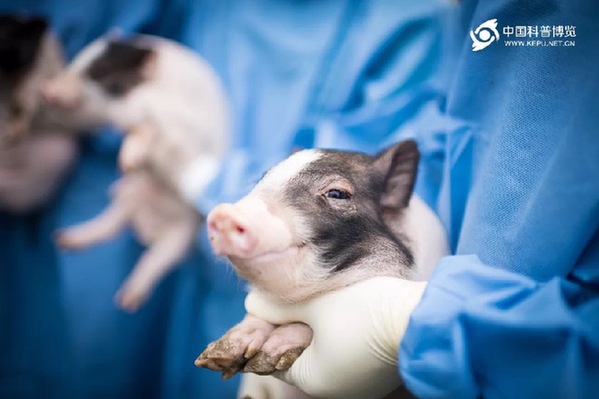In the first half of the year, these new scientific achievements will change your life.
July 3, 2018 Source: Xinhua Author: Anna
Window._bd_share_config={ "common":{ "bdSnsKey":{ },"bdText":"","bdMini":"2","bdMiniList":false,"bdPic":"","bdStyle":" 0","bdSize":"16"},"share":{ }};with(document)0[(getElementsByTagName('head')[0]||body).appendChild(createElement('script')) .src='http://bdimg.share.baidu.com/static/api/js/share.js?v=89860593.js?cdnversion='+~(-new Date()/36e5)];Technological innovation drives reform and development, and innovation results change your life. In the first half of 2018, China has made many new breakthroughs and new discoveries in the field of science. These new achievements constantly refresh the public's scientific and technological perception and are changing your life.
The world's first individual cell cloned monkey has a new prospect in the treatment of severe brain diseases in China

The picture shows the somatic cell cloning monkey "ä¸ä¸" and "Huahua"
The Chinese Academy of Sciences announced at a press conference held on January 24 this year that China has achieved somatic cell clones of non-human primates for the first time in the world. The biology international academic journal Cell has published this achievement in a cover article and was published online on January 25, 2018. This achievement marks China's first new era of somatic cell cloned monkeys as an experimental animal model, and has realized the transformation of China's non-human primate research field from international "running" to "leading".
In addition to its significant significance in basic research, this achievement also contributes to solving major challenges in the field of population health in our country. According to reports, the use of somatic cell cloning technology to make brain disease model monkeys, bringing unprecedented bright prospects for the research, intervention, diagnosis and treatment of human brain diseases.
Chinese scientists take the lead in discovering the mechanism of human embryo activation to lay the foundation for eugenics
In March of this year, the Beijing Genomics Institute of the Chinese Academy of Sciences cooperated with many domestic research institutions to reveal for the first time in the world the mystery of orderly gene expression, development and evolution of human embryos. The research results were published in the international academic journal Cell.
Studies have shown that almost all kinds of cells in human body have a large number of genes. However, about two days after human fertilization is very special, and there is almost no gene expression in the embryo during this time. Scientists have found a key molecule (Oct4) that initiates the expression of the human genome, and found that in the evolutionary history, the first genes (old genes) will be expressed first, and the last genes will often be expressed later. The study also revealed an important new mechanism for human evolution. Scientific research has shown that mutations in DNA cause human evolution. There are a class of DNA fragments called transposons in DNA sequences that often jump from one region to another. This beating produces DNA mutations. The research results open the door to understanding the regulation of human embryonic development gene expression, and will provide a theoretical basis for human prenatal and postnatal care.
The world's first neurological model pig birth promotes treatment of diseases such as Alzheimer's disease

The picture shows the Huntington's disease gene knocking into the pig. Image Source: Popular Science China
According to the Chinese Academy of Sciences, after four years of hard work, the international research team led by Guangdong scientists used the gene editing technology (CRISPR/Cas9) and somatic cell nuclear transfer technology to successfully cultivate the world's first Huntington's disease gene knock-in pig. It can accurately simulate human neurodegenerative diseases, provide stable and reliable animal models for the treatment of Huntington's disease, Alzheimer's disease and other diseases, and promote drug screening and treatment planning. The result was published online in the "Cell" magazine in the early morning of March 30th, Beijing time.
As the world's first Huntington's disease gene knock-in pig model, researchers have introduced the drug research and development industry chain that will develop a large animal disease model in China, and promote neurodegenerative diseases such as Alzheimer's disease and Parkinson's disease, as well as immunity. New drug development process for defects, tumors, and metabolic diseases. At the same time, the animal model can be used for preclinical evaluation of methods such as stem cell therapy, ultimately benefiting humans.
Scientists have discovered that more than 100 genetic loci affecting human hair color provide the possibility for more accurate forensic DNA phenotypic characterization

The picture shows the hair color classification for genome-wide association analysis.
Scientists at the Beijing Genomics Institute of the Chinese Academy of Sciences and other national research institutes have discovered more than 100 genes that affect the color of human hair, breaking the previously recognized human hair color, mainly with several known genetic decisions. Realize the accurate prediction of the hair color of unknown offenders through DNA. The research results were published in the international journal Nature Genetics.
Previous researchers believe that human hair color is mainly determined by several known genes. The study showed that in addition to the known genes, hair color was affected by more than 100 newly discovered genetic loci. The human hair color prediction based on the newly discovered locus has higher accuracy, which is helpful for guiding the subsequent human complex phenotypic genetic research, and provides a possibility for more accurate forensic DNA phenotypic characterization.
Chinese scientists first reveal hydrated ion atomic-level resolution images and magic number effects to shorten battery charging time and increase battery power
Jiang Ying's research team, professor of the Center for Quantum Materials Science, School of Physics, Peking University, obtained the world's first sub-molecular-scale water molecule image in 2014, and obtained the atomic-level resolution image of hydrated sodium ion for the first time in the world. The magic number effect of hydrated ion transport. The result was published on May 14th in the international academic journal Nature.
The results show that it is possible to control the transport of ions in a restricted environment or nanofluid by changing the symmetry and periodicity of the surface lattice, thereby achieving the purpose of selectively enhancing or weakening the transport capacity of an ion. The application fields have important potential implications, such as: ion batteries, corrosion protection, electrochemical reactions, seawater desalination, biological ion channels, and so on. In addition, the experimental technology of the research exhibition also pushed the research precision of hydration interaction to the atomic level for the first time, and it is expected to apply to more extensive hydrate systems in the future, opening up new research fields.
China successfully developed the world's first automatic stem cell induction culture equipment to lay the foundation for regenerative medicine and precision medicine

The picture shows the automatic stem cell induction culture equipment operating platform for the Chinese Academy of Sciences
The “Natural Stem Cell Induction Culture Equipmentâ€, a national major scientific research equipment development project undertaken by the Guangzhou Institute of Biological Sciences of the Chinese Academy of Sciences, has been completed, marking the birth of the world's first automated stem cell-inducing equipment that is unmanned and uses deep neural networks.
This equipment has completely independent intellectual property rights, and has established equipment technology from cell culture, microscopic online observation, pipetting and liquid exchange, algorithm identification, cloning and equipment control, and realized iPSC automated induction culture, amplification, imaging, Pipetting and changing, picking clones, downstream differentiation and other functions. The successful development of the first automatic stem cell induction culture equipment marks a new breakthrough in the independent research and development of stem cell equipment in China, and promotes the development of basic research and clinical application of stem cells in China, laying the foundation for the research of regenerative medicine and precision medicine. Has a broad market prospects.
China's completion of wheat A genome sequencing and fine mapping is expected to accelerate wheat genetic improvement
The research team of the Institute of Genetics and Developmental Biology of the Chinese Academy of Sciences completed the sequencing of wheat A genome and the mapping of chromosome fine maps. It fully revealed the structure and expression characteristics of wheat A genome, and deeply and systematically studied the structure and function of wheat plants. Genomics and further promotion of genetic improvement of cultivated wheat have important theoretical and practical value. The research results were published online on May 10th, Beijing time in the international academic journal Nature.
Researchers pointed out that the completion of wheat A genome sequencing and fine mapping has provided high-quality genomic information and a new perspective for domestic and foreign researchers to analyze wheat genome evolution and domestication. The annotated gene information will help to fine-tune, clone and functionalize the important agronomic trait genes of wheat, accelerate the genetic improvement and molecular design breeding of cultivated wheat, improve the competitiveness of wheat industry, ensure food security and improve quality and efficiency of agriculture. Sustainable development will play an important role.
"Tianyan" FAST first discovered that millisecond pulsar gravitational wave detection adds new possibilities

The picture shows the "Eye of the Eye" FAST (500 m caliber spherical radio telescope)
The National Astronomical Observatory of the Chinese Academy of Sciences reported that the "Tianyan" FAST (500-meter spherical radio telescope) first discovered the millisecond pulsar and was recently certified internationally. This is another important result of FAST following the discovery of the pulsar. The newly discovered pulsar J0318+0253 has a rotation period of 5.19 milliseconds. It is estimated to be about 4,000 light years from the Earth according to the dispersion. The ultra-wideband receiver used by FAST for one-hour tracking observation shows that it is the weakest high-energy millisecond pulsar that has been found so far. one.
What is the significance of this discovery? Researchers have explained that millisecond pulsars are special neutron stars that rotate hundreds of times per second. Their research is not only expected to play an important role in understanding the evolution of neutron stars, the state of strange matter, but also stable millisecond pulsars are low-frequency gravitational wave probes. Pulsar search is the basis for gravitational wave detection. The pulsar timing array is the most effective method for observing gravitational waves from supermassive double black holes. The pulsar timing array relies on dozens of millisecond pulsars with good timing. The expansion of the sample and the improvement in performance begin with the pulsar search. The FAST first discovered millisecond pulsars, demonstrating the potential of FAST to make a substantial contribution to international low-frequency gravitational wave detection. The FAST project has planned the FAST multi-scientific target and the sky survey will find a large number of millisecond pulsars, greatly improving the sensitivity of the pulsar to detect gravitational waves.
The Chinese Academy of Sciences develops new ceramic materials for future "space 3D printing"
The researchers of the Space Application Engineering and Technology Center of the Chinese Academy of Sciences successfully completed the international stereolithography forming technology test of ceramic materials in the microgravity environment and the first casting technology test in the microgravity environment of metal materials in China. High-precision manufacturing of cutting-edge technology and new materials in the microgravity environment, obtaining a number of intact ceramic and metal manufacturing samples and rich experimental data.
The test began on June 12th. As of the afternoon of June 13, a total of 28 microgravities, 2 lunar gravity and 2 Mars gravity flights were carried out. The two sets of equipment were used for ceramic materials and metal materials. A pre-planned manufacturing task resulted in a total of 10 ceramic samples and 8 metal samples.
Scientists have discovered that many large cryptic species provide new scientific support for future protection

The study reveals that Chinese giant salamanders consist of at least five species (possibly eight)
The international research team led by the Kunming Institute of Zoology of the Chinese Academy of Sciences has made significant progress in the study of genetic diversity and conservation of the Chinese giant salamander: the study based on genomic level data reveals that the Chinese giant salamander is composed of at least five species (possibly eight). The result breaks the conclusion that “the Chinese amnesty is a species†that the academic circles have always considered, and provides new scientific guidance and basis for the future protection strategy of China’s amnesty. The research results were published in the international journal "Contemporary Biology" at 0:00 on May 22, Beijing time.
It has been found that many hidden species of Datun provide new scientific support for the future protection of Dagu. According to researchers, based on past classification knowledge and conventional practices, in the protection of protected areas, artificial breeding, proliferation and release, China's giant salamander has long been treated as a species, and does not distinguish between different geographical populations. "If not adjusted in time, not only can some species not be protected, but also small population species can be eroded by other genes or even replaced, resulting in huge loss of genetic resources and even extinction."
Pacific Saury,pacific saury fish,saira fish,sauries fish
Zhoushan Boda Aquatic Products Co.,Ltd , https://www.baida-aquatic.com